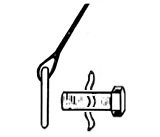|
Please
read these instructions carefully before proceeding.
|
|||||||||||||||||||||||
|
|||||||||||||||||||||||
|
USERS
AND MAINTENANCE INSTRUCTIONS
These should be passed to the owner/driver |
||
FASTENING
THE HARNESS RELEASING
THE HARNESS |
||
|
IMPORTANT • The harness is designed to be used by only one person. • It is important to wear the harness on each journey. • The harness is intended for use by occupants of adult build. • The harness should be adjusted and used in accordance with these instructions. No excessive slackness should be present. • Avoid twisting webbing and ensure that snap hooks are correctly located in the eye bolts. • To avoid damage ensure the harness is stored clear of doors, seat runners etc. • Webbing must not be allowed to chafe against sharp edges on seat or bodywork. • Harnesses that have been cut, frayed, damaged or stressed through impact should be replaced. After impact, anchorages should also be checked. • Regular inspection of the harness is recommended. • To clean webbing use warm soapy water only. Do not use chemical cleaners, bleach or dye under any circumstances. • Contamination with petrol, grease and acid will be detrimental. DO NOT MAKE ALTERATIONS OR ADDITIONS TO THE HARNESS. IF IN DOUBT CONSULT THE MANUFACTURER |












